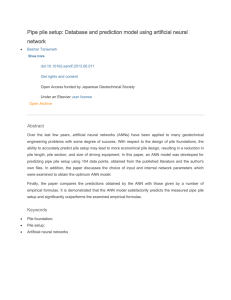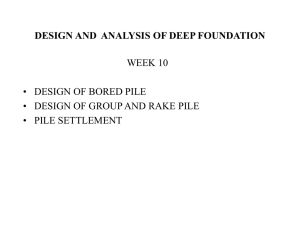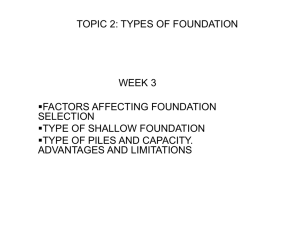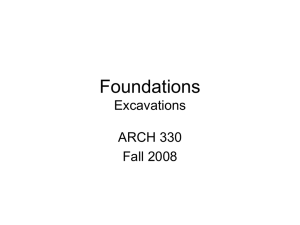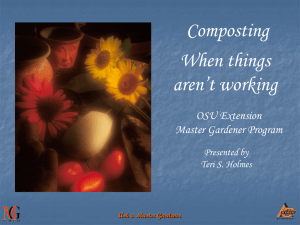Pile-group
advertisement
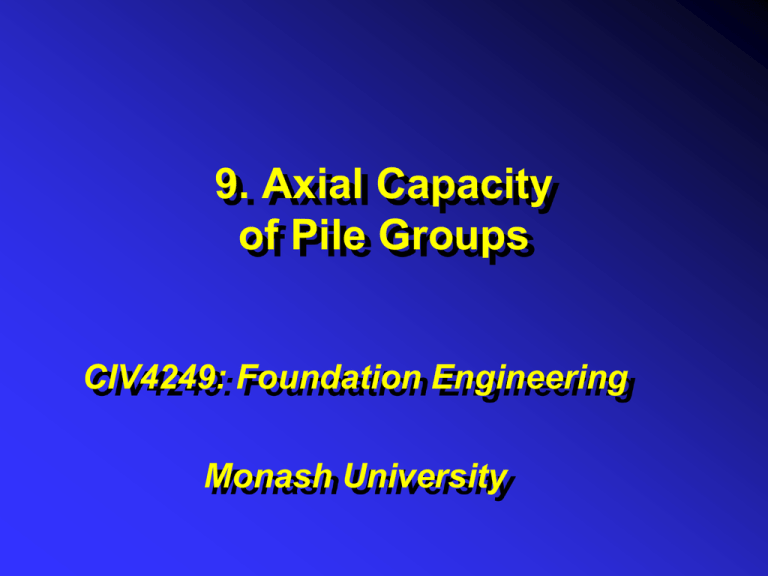
9. Axial Capacity of Pile Groups CIV4249: Foundation Engineering Monash University Fu Fu + WCapacity = Pbase + Pshaft Axial Pshaft Shear failure at pile shaft W Pbase Bearing failure at the pile base Tension Capacity Tu - W = Pshaft,t < Pshaft,c Pshaft,t Shear failure at pile shaft Applications Large Distributed Weight Very Large Concentrated Weight Low Weight Soft to Firm Clay Dense Sand Strong Rock ug Group PCapacity Pile Cap • • • • Overlapping stress fields Progressive densification Progressive loosening Case-by-case basis Pug n.Pup Pug = e.n.Pup Efficiency, e Pile Cap n = 5 x 5 = 25 Clay Soil Type of Piles, n Number Spacing/Diameter d Sand s s/d typically > 2 to 3 Rock Types of Groups Free-standing Capped Flexible Cap Rigid Cap Feld Rule for free-standing piles in clay 13/16 11/16 A B B B A reduce capacity of each pile by 1/16 for each adjoing pile B 8/16 C C C B e = 1/15 * (4 * 13/16 + 8 * 11/16 + 3 * 8/16) = 0.683 A B B B A Converse-Labarre Formula for free-standing piles in clay n = # cols = 5 e = 1 - q (n-1)m + (m-1)n 90 mn q= d=0.3 tan-1(d/s) s = 0.75 e = 0.645 m = # rows = 3 Block Failure Flexible Cap PBL = BLcbNc + 2(B+L)Dcs D cs Nc incl shape & depth factors cb L,B Pug = min (nPup,PBL) Empirical Modification PBL = BLcbNc + 2(B+L)Dcs Pug = min (nPup,PBL) 1 1 1 P2ug = n2P2up + P2BL nPup 1 = 1 + n2P2 up e2 P2BL n Block Failure Flexible Cap D = 20m d = 0.3m L = B = 5m cs = cb = 50 kPa Capped Groups Bc x Lc Rigid Cap Ptotal = Pgroup + Pcap for single group pile block failure, failure,PP = =ccap ccap NN [B[B Lc- nA - BL] cap cap cc cL cc p ] BxL Efficiency increases 1.0 72 capped 0.9 0.8 0.7 72 free-standing 0.6 0.5 0.4 s/d 0.3 1 2 3 4 Piles in Granular Soils • End bearing - little interaction, e = 1 • Shaft - driven – For loose to medium sands, e > 1 – Vesic driven : 1.3 to 2 for s/d = 3 to 2 – Dense/V dense - loosening? • Shaft - bored – Generally minor component, e = 1 Pile Settlement Elastic Analysis Methods • based on Mindlin’s equations for shear loading within an elastic halfspace • Poulos and Davis (1980) • assumes elasticity - i.e. immediate and reversible • OK for settlement at working loads if reasonable FOS • use small strain modulus Definitions Area Ratio, Ap Pile Stiffness Factor, K RA = Ap / As K = RA.Ep/Es Ap Ep As Es Floating Pile • % load at the base b = boCKCn L Ep Es,n d Rigid Stratum • Pile top settlement h r = P.IoRKRLRn / Esd Solutions are independent of soil strength and pile capacity. Why? P = 1800 kN Floating pile example b = boCKCn Ep = 35,000 MPa 25 0.5 32 Es = 35 MPa n = 0.3 Rigid Stratum r = P.IoRKRLRn / Esd bo = 0.038 CK = 0.74 Cn = 0.79 b = .022 Pb = 40 kN Effect of : L = 15m db/d = 2 h = 100m Io = 0.043 RK = 1.4 RL = 0.78 Rn = 0.93 r = 4.5mm Pile on a stiffer stratum • % load at the base b = boCKCbCn L Ep Es,n d Stiffer Stratum Eb > Es • Pile top settlement r = P.IoRKRbRn / Esd Layered Soils L Ep E1,n1 E2,n2 d Stiffer Stratum Eb > Es Es = 1 L S Ei hi P = 1800 kN Stiffer base layer example b = boCKCbCn r = P.IoRKRbRn / Esd n = 0.3 Ep = 35,000 MPa 25 Es = 35 MPa 0.5 Eb = 70 MPa bo = 0.038 CK = 0.74 Cn = 0.79 Cb = 2.1 b = .0467 Pb = 84 kN Io = 0.043 RK = 1.4 Rb = 0.99 Rn = 0.93 r = 4.5 mm Effect of: Es = 15 MPa to 15m Movement Ratios • MR is ratio of settlement to PL/AE • Focht (1967) - suggested in general : 0.5 < MR < 2 • See Poulos and Davis Figs 5.23 and 5.24 Pile group settlment • Floating Piles • End bearing piles r g Rs r p Single pile settlement is computed for average working load per pile

